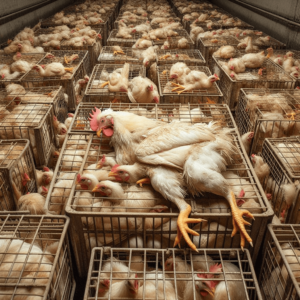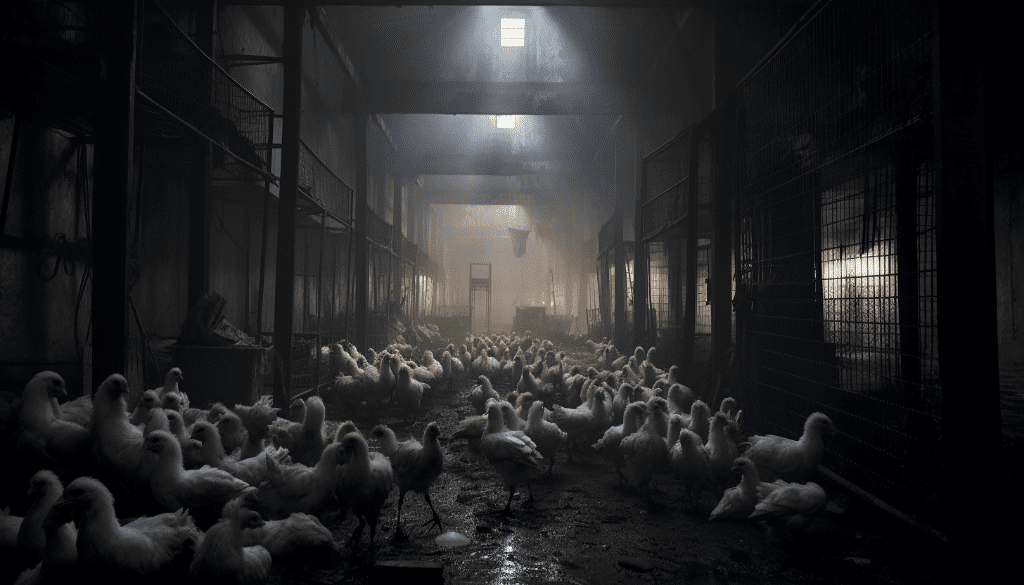Index of Contents
ToggleIntroduction
Animal cruelty is a heart-wrenching issue that demands our attention and compassion. While the mistreatment of all animals is deeply concerning, today we turn our focus toward an often overlooked and troubling reality: the plight of chicks. These helpless creatures, symbolizing innocence and new life, are subjected to unimaginable cruelty in various industries across the globe. It is our duty to shed light on this disturbing issue and advocate for the ethical treatment of these vulnerable beings, granting them the compassion and respect they deserve.
Tucked away in cramped cages or confined within dark and overcrowded spaces, chicks endure immense suffering from the moment they hatch. The commercial exploitation of these fragile creatures often involves inhumane practices, such as beak mutilation without anesthesia, overcrowding leading to injury or suffocation, and brutal handling during transportation. These distressing conditions are not only in violation of their basic rights, but they also reflect a disturbing and callous disregard for their wellbeing. As compassionate individuals, we must confront the reality of animal cruelty in chicks, challenging the status quo and advocating for a more compassionate approach that respects their inherent worth and dignity.
1. The hidden truth: Uncovering the widespread abuse of chicks in factory farming. 2. Shocking practices: Exploring the inhumane conditions endured by chicks in commercial hatcheries. 3. The psychological impact: Understanding the long-lasting effects of animal cruelty on chicks. 4. Taking a stand: Examining the initiatives and organizations working to combat chick abuse. 5. Empowering change: Practical steps individuals can take to make a difference for chicks in distress.
1. The hidden truth: Uncovering the widespread abuse of chicks in factory farming.
The hidden truth: Uncovering the widespread abuse of chicks in factory farming In an era where animals are increasingly seen as sentient beings deserving of respect and compassion, it is both shocking and disheartening to uncover the widespread abuse of chicks in factory farming. While the world is becoming more aware of the ethical treatment of animals, it seems that these innocent creatures have been left behind, trapped in a cycle of suffering and cruelty.
Factory farming has become the dominant method of poultry production, driven by the demand for cheap and readily available meat. However, behind the glossy packaging and promises of efficiency, lies a disturbing reality that we, as a society, cannot afford to ignore. Chicks, who should be experiencing the warmth and comfort of a mother hen, are subjected to unimaginable cruelty from the moment they enter this cruel system. One of the most distressing practices in factory farming is the practice of debeaking.
Debeaking, or beak trimming, involves the removal of a significant portion of the chick’s beak using hot blades or lasers, often without anesthesia. This procedure is done to prevent feather and cannibalism-related injuries caused by the stressful, unnatural environment these birds are forced to endure. Imagine the pain and suffering these fragile creatures endure, only to have their essential anatomy permanently altered. Another horrifying aspect of factory farming is the practice of overcrowding. Chicks are crammed into tiny, cramped cages or barns, with no space to move or stretch their wings.
These overcrowded conditions lead to intensified stress, diseases, and the inability to engage in natural behaviors. The heartbreaking reality is that these poor chicks are robbed of experiencing the simple pleasures of spreading their wings, wandering around freely, and experiencing life as nature intended. As if the physical suffering were not enough, chicks in factory farms are also subjected to psychological torment.
They are deprived of natural light, fresh air, and social interactions, leading to increased stress, anxiety, and ultimately, a compromised immune system. These innocent creatures long for companionship and a sense of belonging, yet they are trapped in an environment devoid of any semblance of a normal life. Furthermore, the issue of male chicks is deeply troubling. In the egg industry, male chicks are deemed useless as they cannot lay eggs or grow at the same rate as their genetically manipulated counterparts. As a result, male chicks are considered nothing more than disposable commodities. They are often subjected to brutal methods of euthanasia, such as gassing or maceration, where they are essentially ground alive.
This ruthless practice is a stark reminder of the callousness that exists within the factory farming industry. It is crucial to acknowledge that our choices as consumers directly impact the lives of these vulnerable creatures. By supporting more humane alternatives, such as free-range or organic farming, we can send a powerful message that we will not stand for the inhumane treatment of animals. Operating on the principle of compassion, we can create a future where chicks and all animals are treated with the dignity and respect they deserve.
In conclusion, the hidden truth surrounding the widespread abuse of chicks in factory farming is an issue that demands our attention. As a society, it is our moral obligation to confront these injustices and strive for a more compassionate world. The time has come to shine a light on the suffering endured by these innocent creatures and work towards a future where they are treated with the kindness and compassion they so inherently deserve.
2. Shocking practices: Exploring the inhumane conditions endured by chicks in commercial hatcheries.
2. Shocking practices: Exploring the inhumane conditions endured by chicks in commercial hatcheries In the seemingly idyllic world of chick production, there lies a dark reality hidden away from public view. Commercial hatcheries, where the vast majority of chicks are born, house thousands upon thousands of these vulnerable creatures in deplorable conditions. As we delve into the heart-wrenching practices that take place within these facilities, prepare yourself for a glimpse into the disturbing reality endured by these innocent beings. Venturing into a commercial hatchery, one is immediately struck by the overwhelming noise, the pungent odor, and the sight of cramped and overcrowded spaces.
Chicks are packed like sardines in tightly stacked trays, with minimal room to move or spread their wings. This inhumane confinement significantly impairs their physical and psychological well-being, leaving them unable to express their natural behaviors. The temperature inside these hatcheries is meticulously controlled, but it often falls far from the warmth that these vulnerable creatures so desperately need. Losses due to exposure are not an uncommon occurrence, as the delicate bodies of the chicks struggle to cope with the surrounding cold and harsh conditions. It is an inherently cruel cycle that condemns them to suffer from the moment they enter this world. Under the artificial lighting of these hatcheries, chicks are exposed to constant bright illumination to maximize growth.
This unnatural environment subjects them to severe levels of stress and disrupts their natural circadian rhythms. Is it any wonder that these innocent beings, who would naturally spend their days exploring and foraging, instead develop into stressed and fearful individuals? While nature intended for a mother hen to meticulously care for her brood, commercial hatcheries strip away this elemental bond. As soon as they hatch, chicks are meticulously sorted, with males culled in mass numbers due to their lack of economic value. The discarded males are often subjected to gruesome deaths, suffocated in bags or ground up alive in machines.
This is nothing short of a heart-wrenching fate for these defenseless creatures who should have been nurtured and loved. Sadly, these practices persist due to the insatiable demand for poultry products and the relentless pursuit of profit. The chick hatcheries are designed to operate as efficient factories, catering to the growing global demand for chicken meat and eggs. This unforgiving focus on productivity and economic gain results in a complete disregard for the wellbeing of the chicks that fuel this industry. As compassionate individuals, it is our responsibility to shed light on this darkness and demand change. We must strive for a society that values the lives and welfare of these vulnerable creatures over the demands of profit.
Instead of supporting the commercial hatchery industry, we have the power to opt for alternatives that promote ethical practices and provide a more compassionate existence for all beings. In conclusion, the conditions endured by chicks in commercial hatcheries are nothing short of disturbing and heart-wrenching. Their lives are compromised from the moment they enter this world, subjected to inhumane confinement, exposure, stress, and the heartbreaking loss of their natural bond with their mother. It is incumbent upon us to raise awareness, demand change, and choose compassion over convenience. Together, we can create a world in which animals are treated with the care and respect that they deserve.
3. The psychological impact: Understanding the long-lasting effects of animal cruelty on chicks.
The psychological impact: Understanding the long-lasting effects of animal cruelty on chicks Animal cruelty is a distressing reality that plagues our society, and one area that deserves particular attention is the mistreatment of defenseless chicks. These innocent creatures, dependent on humans for every aspect of their well-being, are subjected to unimaginable cruelty that has severe psychological consequences. It is crucial to acknowledge and understand the long-lasting impact that animal cruelty has on the emotional and mental well-being of these vulnerable beings. Chicks, especially during their early stages of development, possess a remarkable ability to form emotional attachments.
These social creatures rely on their peers and caregivers to provide warmth, security, and companionship. However, when exposed to cruel and abusive conditions, these innate needs are neglected, leaving lasting emotional scars that can hinder their growth and development. Imagine a newly hatched chick, expecting to be embraced by warmth and nurturing, only to face a harsh reality of neglect and abuse. These chicks are typically packed into overcrowded environments, denied the freedom to roam and explore their surroundings. Instead of feeling the soft comfort of their mother’s feathers or the gentle pecking of their siblings, they endure cramped spaces devoid of any opportunity for social interaction. This lack of socialization severely impacts their ability to establish crucial social bonds, leading to feelings of loneliness, fear, and anxiety.
Additionally, the constant exposure to loud noises, rough handling, and harsh environments instills a profound sense of vulnerability and helplessness in these innocent beings. Cruelty hinders their ability to trust humans, and they may develop an intense fear response to any human interaction. This fear can persist long after the immediate mistreatment has ceased, leaving them emotionally scarred and wary of future human interactions. Many studies have indicated that animals subjected to cruelty, including chicks, exhibit symptoms of post-traumatic stress disorder (PTSD). They may exhibit a range of behavioral abnormalities, such as aggression, self-mutilation, excessive feather plucking, and repetitive, obsessive behaviors.
These symptoms are clear indications of the long-lasting psychological impact that animal cruelty has on their mental well-being. Furthermore, chicks who have experienced cruelty often struggle with learning and cognitive development. Their cognitive abilities are hindered by the constant stress and fear they endure. They may have difficulty focusing, learning simple tasks, or adapting to new environments. These challenges affect their ability to thrive and integrate successfully into their habitat, further worsening their emotional well-being. It is crucial for society as a whole to comprehend the profound psychological suffering experienced by chicks that are victims of cruelty.
By acknowledging the impact that our actions have on these delicate creatures, we can take meaningful steps towards creating a more compassionate and nurturing environment for them. In conclusion, the psychological impact of animal cruelty on chicks carries long-lasting consequences that affect their emotional and mental well-being. The severe and neglectful conditions experienced during their early stages of development leave them emotionally scarred and hinder their ability to form healthy social bonds. The fear, anxiety, and vulnerability they endure can result in debilitating behavioral abnormalities and hinder cognitive development. Understanding and addressing the psychological impact of animal cruelty is essential for society to foster a world that is compassionate and caring towards all living beings.
4. Taking a stand: Examining the initiatives and organizations working to combat chick abuse.
4. Taking a stand: Examining the initiatives and organizations working to combat chick abuse. In the face of the distressing reality of animal cruelty in the chick industry, there are countless individuals, initiatives, and organizations dedicated to combating this abuse. Their unwavering commitment to the welfare of these innocent creatures shines a light of hope in an otherwise gloomy scenario. It is through their determination and compassion that we are able to envision a more humane future for these vulnerable beings. One such example is the Humane Society of the United States (HSUS), which has been at the forefront of animal welfare for decades.
Recognizing the need for systemic change, the HSUS established the Farm Animal Protection Program to address issues of cruelty and neglect in industrial farming. They work tirelessly to reform industry practices and promote the implementation of animal welfare standards. Through public awareness campaigns, lobbying for policy changes, and advocating for stronger animal protection laws, the HSUS strives to ensure that chicks and other farm animals are treated with compassion, dignity, and respect. In addition to larger organizations, there are also numerous grassroots initiatives that champion the cause of animal welfare. One such initiative is the Chickenshed Rescue, a volunteer-run sanctuary dedicated to rescuing and rehabilitating abused and neglected chickens.
They provide a safe haven for these animals, nursing them back to health and offering them the opportunity to live out their lives free from harm. Through education and outreach programs, Chickenshed Rescue also endeavors to raise awareness about the plight of chicks in the poultry industry, inspiring individuals to make more compassionate choices. Another remarkable organization fighting against chick abuse is Compassion in World Farming (CIWF). Established over 50 years ago, CIWF is a leading voice in the global movement to end factory farming. They tirelessly campaign for improved animal welfare standards and promote the adoption of more ethical farming practices.
By working closely with governments, businesses, and consumers, CIWF strives to create a world where all animals are treated with compassion, including chicks who often fall victim to the cruel realities of industrial farming. On a more local level, there are animal sanctuaries and rescue organizations that devote themselves to providing refuge to abandoned, abused, and neglected chicks. These sanctuaries not only provide shelter and care but also serve as educational centers, promoting a deeper understanding of the lives and needs of these beautiful creatures.
By opening their doors to the public, they encourage visitors to connect with these animals on a personal level, fostering empathy and compassion in their hearts.These initiatives and organizations inspire us to take a stand against chick abuse and make informed choices. Whether through supporting legislative efforts, volunteering at sanctuaries, or adopting a plant-based diet, each small step we take can contribute to creating a kinder world for these vulnerable creatures.
By embracing compassion, we can help forge a brighter future—a future where chicks are no longer subjected to the cruelties that have plagued them for far too long. In conclusion, the initiatives and organizations dedicated to combating animal cruelty in the chick industry serve as beacons of hope amidst a deeply troubling reality. Through their unwavering commitment and compassion, these organizations strive to transform the way we perceive and treat chicks. They remind us that together, through our collective efforts, we can make a difference, and ultimately pave the way towards a more humane and compassionate world.
5. Empowering change: Practical steps individuals can take to make a difference for chicks in distress.
Empowering Change: Practical Steps Individuals Can Take to Make a Difference for Chicks in Distress When we become aware of the disturbing reality of animal cruelty in chicks, it is human nature to feel a deep sense of compassion and a strong desire to make a difference. While the issue may seem overwhelming, there are practical steps that each of us can take to empower change and improve the lives of these innocent beings.
1. Educate Yourself: Begin by educating yourself about the various forms of animal cruelty that chicks endure. Research the industrial practices and conditions they are subjected to, the emotional and physical distress they go through, and the realities of their short lives. Knowledge is power, and only by understanding the extent of the problem can we effectively address it.
2. Support Ethical Farms: One way to make a tangible difference is by supporting ethical farms that prioritize the wellbeing of chicks. Look for farms that employ humane practices, such as providing ample space, access to natural sunlight, and a healthy diet. By purchasing eggs and poultry products from these farms, you can contribute to the demand for responsible and compassionate farming methods.
3. Choose Cruelty-Free Brands: Extend your compassion by opting for cruelty-free brands that do not harm chicks or any other animals in their testing or production processes. Many companies now offer cruelty-free alternatives for cosmetic and household products, allowing us to make conscious choices that align with our values.
4. Advocate for Change: Raise your voice and advocate for change. Contact your local representatives and express your concerns about animal welfare and the need for stricter laws and regulations to protect chicks. Join or support organizations that fight against animal cruelty, as they often have initiatives and campaigns aimed at raising awareness and creating lasting change.
5. Educate Others: Spread awareness about the issue of animal cruelty in chicks to your family, friends, and colleagues. Share educational materials, news articles, or documentaries that shed light on the topic. Engage in meaningful conversations and emphasize the importance of treating all living beings with compassion and respect.
6. Foster Empathy: Encourage empathy and compassion towards animals in younger generations. Teach children to respect and care for all creatures, instilling in them a sense of responsibility towards the wellbeing of animals. By fostering empathy from an early age, we can shape a future where chicks and other animals are treated with kindness and dignity.
7. Support Animal Rescue Organizations: Consider donating your time or resources to animal rescue organizations that provide care and rehabilitation for chicks and other animals rescued from the cruelty of industrial farming. These organizations rely heavily on the support of compassionate individuals to continue their vital work. Remember, change starts with individual actions. By taking these practical steps and influencing those around us, we can help create a compassionate world where chicks are no longer subjected to distressing conditions and cruelty. Let us be the voice for those who cannot speak for themselves and work together towards building a brighter future for all animals.
In conclusion, the issue of animal cruelty in chicks is a deeply disturbing reality that demands our attention and immediate action. The profound suffering endured by these innocent creatures should not be dismissed or ignored any longer. By turning a blind eye to the cruelties inflicted upon them, we perpetuate a cycle of abuse that tarnishes our humanity. It is crucial that we approach this issue with compassion and empathy, recognizing the worth and inherent dignity of all living beings, regardless of their species. Our moral obligation to protect animals goes beyond whether they are cute or cuddly, extending to even the smallest and most vulnerable amongst us.
By raising awareness about the disturbing conditions under which these chicks are raised, we can inspire change and advocate for stronger ethical standards in the agricultural sector. Through education, legislation, and promoting alternative farming practices, we can strive to eliminate animal cruelty and create a more compassionate world. Let us not forget that our choices have the power to shape the lives of countless creatures. By embracing a more humane approach and collectively rejecting the acceptance of animal cruelty, we can work towards a future where chicks and all animals, can live free from fear and suffering. Together, let us forge a path towards a kinder and more compassionate society—one that cherishes the wellbeing and lives of all living beings, including the smallest, most vulnerable chicks.



